21. May 2021
Christof Faller









Opera Zurich Stage Monitoring
Can Clarity improve monitoring on opera stage?


21. May 2021
Christof Faller









Can Clarity improve monitoring on opera stage?
Introduction
Believe it or not, many of today’s state-of-the-art operas feature a monitoring system for the main stage, such that singers hear the orchestra more clearly. Not monitoring with visible loudspeakers or in-ear, but discrete loudspeakers for enhancing orchestra’s sound on stage for the singers and artists (not for audience!).
Opera Zurich uses four boundary microphones in the orchestra area to pick up sound, which is routed to some or all of the eight monitoring loudspeakers, depending on the stage design.
Micheal Utz from Opernhaus Zürich had been an Illusonic Test-Balloon Plug-Ins user for a while. When we released the first version of the Clarity plug-in, we received feedback from him on its application for dereverberation. We mentioned that this plug-in was designed for low delay and could be used for live applications as well. This was the start of a fruitful investigative collaboration.
While normally, the opera house stage is extremely busy and time-intensive testing is very difficult, the exceptional situation due to Covid resulted in that the stage was occasionally free for a few hours – ideal for testing! So far we accomplished three goals: 1 measurement of the eight monitoring loudspeakers at different positions of the stage, 2 tuning of the monitoring (EQ and Clarity), and 3 testing by playing back orchestra music. Point 3 turned out very well, everyone in the test agreed that sound everywhere on stage became more clear. A real live test with orchestra and singers is currently not possible, as due to Covid the orchestra can’t play on-site.
More details on points 1 to 3:
1 Measurement
The eight monitoring loudspeakers were measured at different positions on the opera stage with Illusonic CalibrationTool (aka IAP Calibration) software, using an RME Fireface UC interface with measurement microphone connected via ADAT to the monitoring system’s Yamaha mixing console.
2 Tuning
Using CalibrationTool and its headphones auralization feature, Michal Utz tuned the monitoring system via headphones and then tested and refined it with music playback on stage. Once his tuning and testing was finished, he invited us for a test together.
3 Testing
We played different orchestra music and listened from different positions on stage. A good test was also walking around on stage and listening.
Clarity made sound more precise everywhere on stage. There is now hope that with less level live amplified orchestra sound will be more clear for the artists. This would allow monitoring at lower level, which has many advantages, such as:
Less acoustic feedback
Less leakage to audience
Stay tuned for more news on this topic.


16. April 2024

In addition to news here on the blog, we post weekly and sometimes even daily news on our Facebook and LinkedIn pages


15. April 2024
Christof Faller



First public Wide Stereo demo
It has been a great show.
Hardware:
– Illusonic IAP 8
– 2x Klangwerk Phil as main stereo loudspeakers
– 2x Klangwerk Muro for wide stereo
– Our amazing subwoofer with membrane control
– Thorens
– Roon Nucleus, iPad
Point of demo:
Extend a stereo system with subwoofer and wide stereo.
Extremely spatial sound stage, yet precise. Live sound feeling.
Works on all kinds of music and sources.
Teaser video below.
Fotos by and © Rudolf Moser, Zürich


23. March 2024
Christof Faller




Optimisation of live speech in soccer stadium
After previous Clarity extreme tests (in terms of room size and reverberance), in University of Zurich Lichthof and Aula room, we had the opportunity to test Clarity for live speech application in St. Jakob-Park Stadium in Basel.
The stadium’s PA was measured to several microphone positions. Additionally, it was measured via a NTI talkbox and wireless microphone to simulate real world condistions. Based on the measurements we did configure Clarity, which run on a Raspberry Pi 3B with 2ms latency.
Surprisingly, the effect of Clarity on the speech was more pronounced than in the previous extreme tests. An ad hoc STI measurement (STIPA) showed a significant improvement!
Based on feedback on this test, we
Optimize Clarity for speech to prevent that it sounds sometimes a bit chopped-up (merely a tuning question, we did indeed tune it aggressively, or adding a decay parameter for limiting decay speed?).
Add network audio to the Raspberry Pi 3B to facilitate integration of it into PA systems (for this test we used analogue i/o).


19. January 2024
Christof Faller
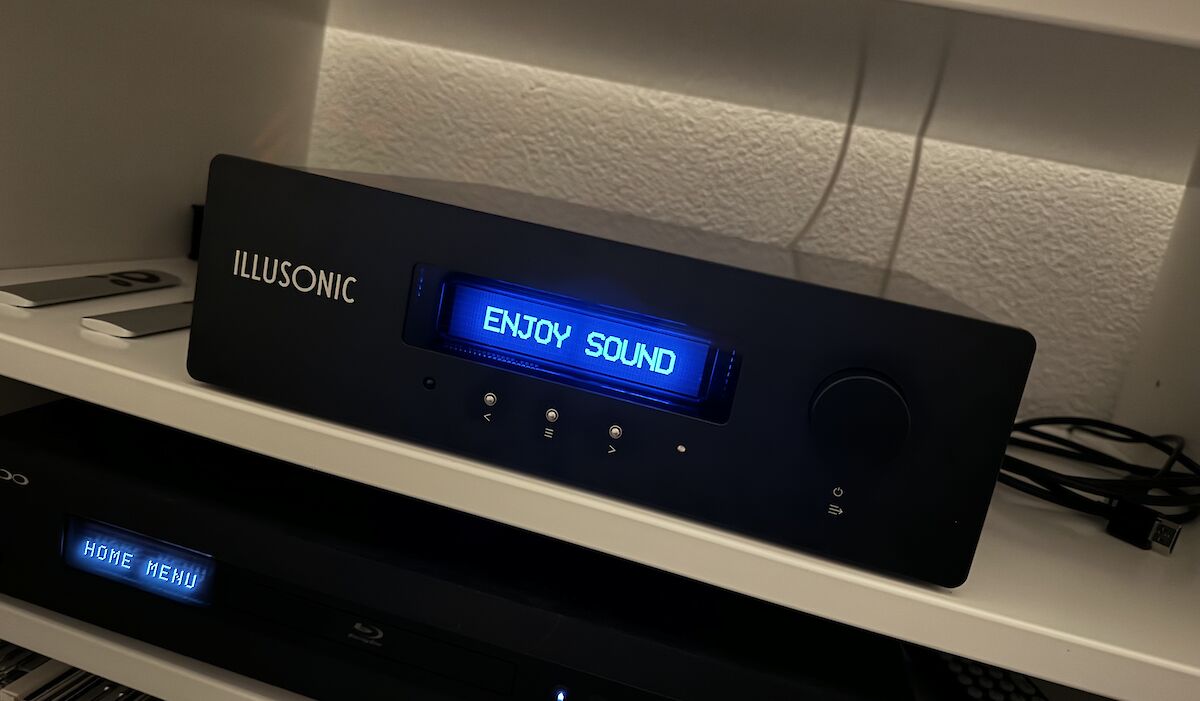


Enjoy Sound
IAP 9.1 Firmware/Software Update
Do you love the precision of stereo, but miss immersion of surround? Then Wide-Stereo is something for you, supported by all IAPs with more than two channels. Wide stereo can be implemented with 4 or more loudspeakers.
Due to great feedback from our customers, partners, and dealers after 9.0 release with Wide-Stereo, we focused on this feature and are updating IAP 4, IAP 8, and IAP 16 with supporting features.
With this, you can get breathtaking advance over stereo, without giving up your beloved Stereo Phantom Centre. Surely, if you have it already, you can use your Centre loudspeaker with it, too.
Besides this, there are many other small improvemnents.
Download here.
Changelog compared to preivous IAP 9.0
IAP Firmware
update wide stereo with side eq to make it less bright
update wide stereo with separate center and width parameters
update wide stereo that it also works with multichannel input
iap4: add 4-II loudspeaker setup
iap8: add 4-II, 5-II, 6-II, and 7-II loudspeaker setups
increased bass management XO max frequency to 1000 Hz
added Center Spk gain to ad hoc settings
bug-fix where auro6/auro8 HDMI input was not loaded from files properly (iap 2/4/8)
IAP Configuration
iap4: add 4-II loudspeaker setup
iap8: add 4-II, 5-II, 6-II, and 7-II loudspeaker setups
add new separate width control (instead of wide stereo on/off)
moved preset lowcut outside of Illusonic Processing
added Center Spk gain to ad hoc settings
fixed a bug where .iap file was not always written properly
various reliability improvements
IAP Calibration
iap4: add 4-II loudspeaker setup
iap8: add 4-II, 5-II, 6-II, and 7-II loudspeaker setups
add new separate width control (internally)
fixed a bug where .iap file was not always written properly
various reliability improvements
IAP Control (iOS)
adapt parameters to IAP 9.1
tuned sliders’ skew factors


27. October 2023

Major update for all IAP processors
IAP 9.0 Firmware/Software Update Released Today
Download:
https://www.illusonic.com/en/audio-processors/support-downloads/
A full year in the works, major IAP 9 firmware/software implements many improvements and extensions.
See images for quick overview of major new features.
The change-log below gives a list of changes and extensions over previous version.
Yet again, we have been able to propagate lastest DSP-technology-improvements to IAP (yes, signal processor of all IAPs has still been sufficient):
Immersive: half a dozen of pro-audio plugins updates are now in IAP
Pro-Acoustics/Pro-Audio: Clarity (world’s only “DSP-based absorbers”), latest version, now in IAP
A new broadcast immersive mode is optimized for film, news, TV
These main new features have been motivated by IAP-owner requests:
wide stereo: listen to stereo, with a widened stereo stage, in your multichannel setup
new preset params (lowcut, center-gain) with existing params, allow for great night, casual listening, movies presets
CHANGELOG (compared to IAP 8.4):
IAP Firmware/DSP
- added new option “forget changes” (system menu):
- iap will never save any changes permanently
- added new option “volume lock” (system menu):
- this locks volume changes via front-panel or remote control
- improvement of center feature (eq, time-resolution, artefacts)
- improvement of clarity (time-resolution, effectiveness)
- new broadcast upmix feature
- new wide stereo upmix feature
- removed mono upmix feature
- bug-fix where multich center input was lost when loudspeaker setup
had no center spk
- added new parameters to sound settings presets:
- low cut
- phantomcenter/center gain
- added new option “volume lock” (system menu):
- this locks volume changes via front-panel or remote control
(only gen2 IAP)
- added new option “output digital” (output menu):
- reverts coax 2 from input to output
(only gen2 mk2 IAP)
- revised input source handling, more smooth now
- added support for upcoming new HDMI card/chipset
- added usb commands for ad hoc settings
(IAP 16 wide, other models have had it already)
IAP Configuration
-add support for new broadcast upmix feature
-add support for new forget changes feature
-add support for new volume lock feature
-add support for new output digital feature
-improve HDMI updating, removing one power down-up
-fixed some layout problems with IAP 16 wide
-upgraded Windows version from win32 to x86
IAP Calibration
-reorg of complete application
-support for new usb heatracker
-add support for new broadcast upmix feature
-added clock-drift correction when two different audio devices are
used for measurement
-upgraded Windows version from win32 to x86


4. July 2023

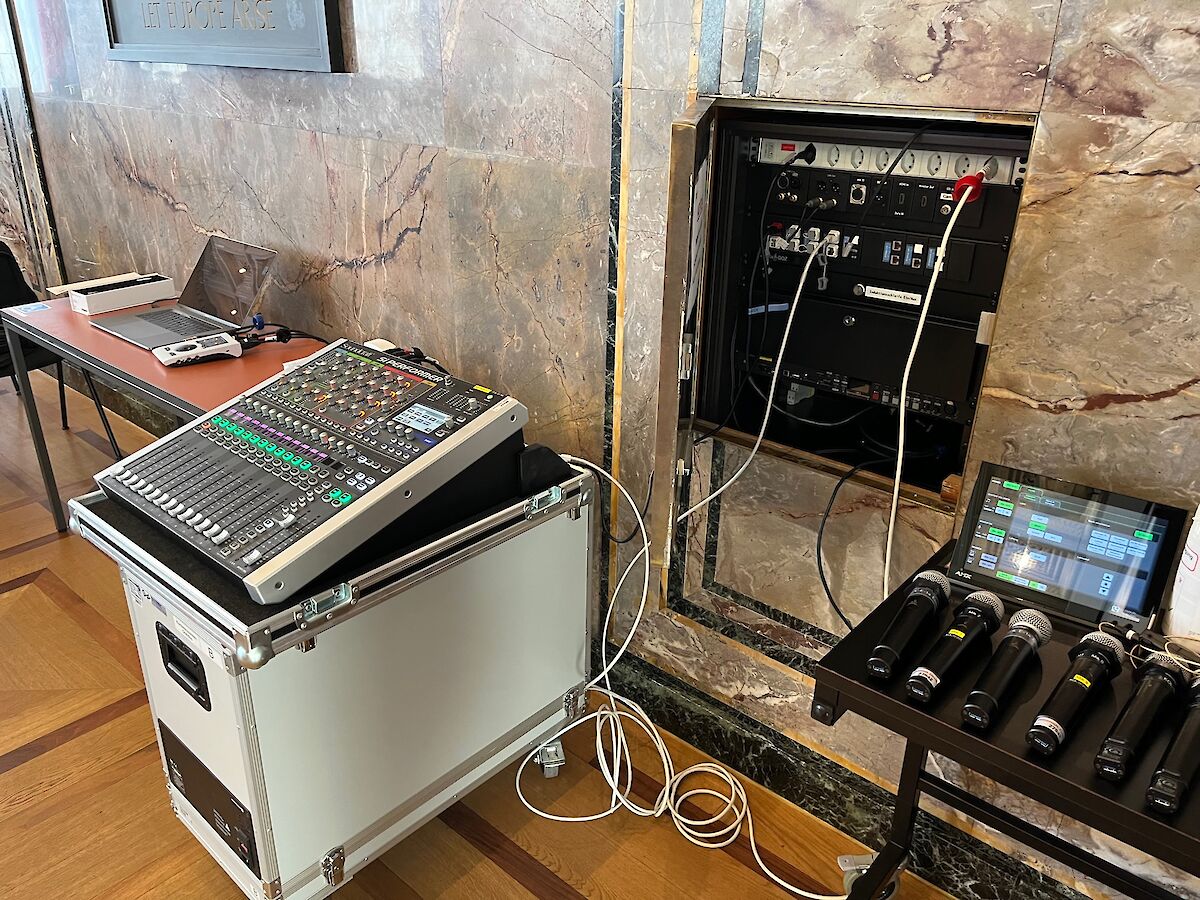




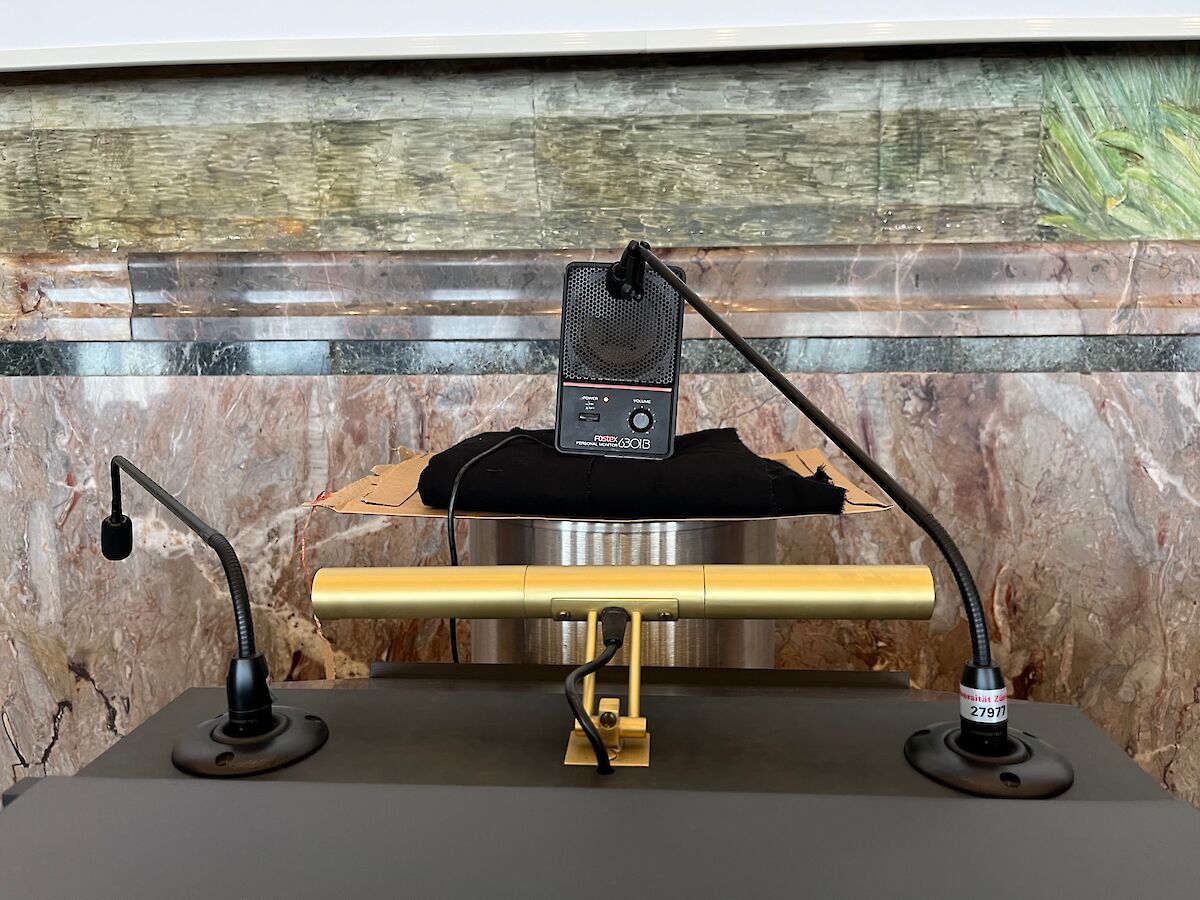



University of Zurich Assembly Hall (Aula) improvements via DSP
Thanks to real-world acoustic and sound experts, Mike Utz from Zurich University UHZ and Christopher Sauder from ETH Zurich, for making this sophisticated test possible!
The historic assembly hall of university of Zurich, where Churchill gave his famous speech after world war in 1946, is acoustically not so optimal. The marble walls do not like to be covered by curtains or acoustic absorbers, they are visually too nice.
Can Illusonic Clarity measurably improve the situation?
I have been a bit sceptical (Christof, Illusonic), as I have been aware of discussions about audio quality and perceptual audio coding, and trying to measure such codecs with conventional (linear-assuming) measurement equipment.
We have measured the PA system of the hall with a small Fostex loudspeaker placed as a “speaker simulator” near the main mics. Based on this data Clarity has been optimized. Note that measuring through the speaker’s mic, includes the acoustic feedback path.
Then, speech-transmission-index (STI) was measured on several positions, throughout the hall. NTi talkbox simulated the speaker on the main mic and NTi measurement device and mic was used to estimate STI on the different positions. There has been consistent improvement between 1 and 3 points throughout the hall. In the back of the hall, where sound has been more diffuse, improvement has been larger. Amazing, cool!


13. January 2023

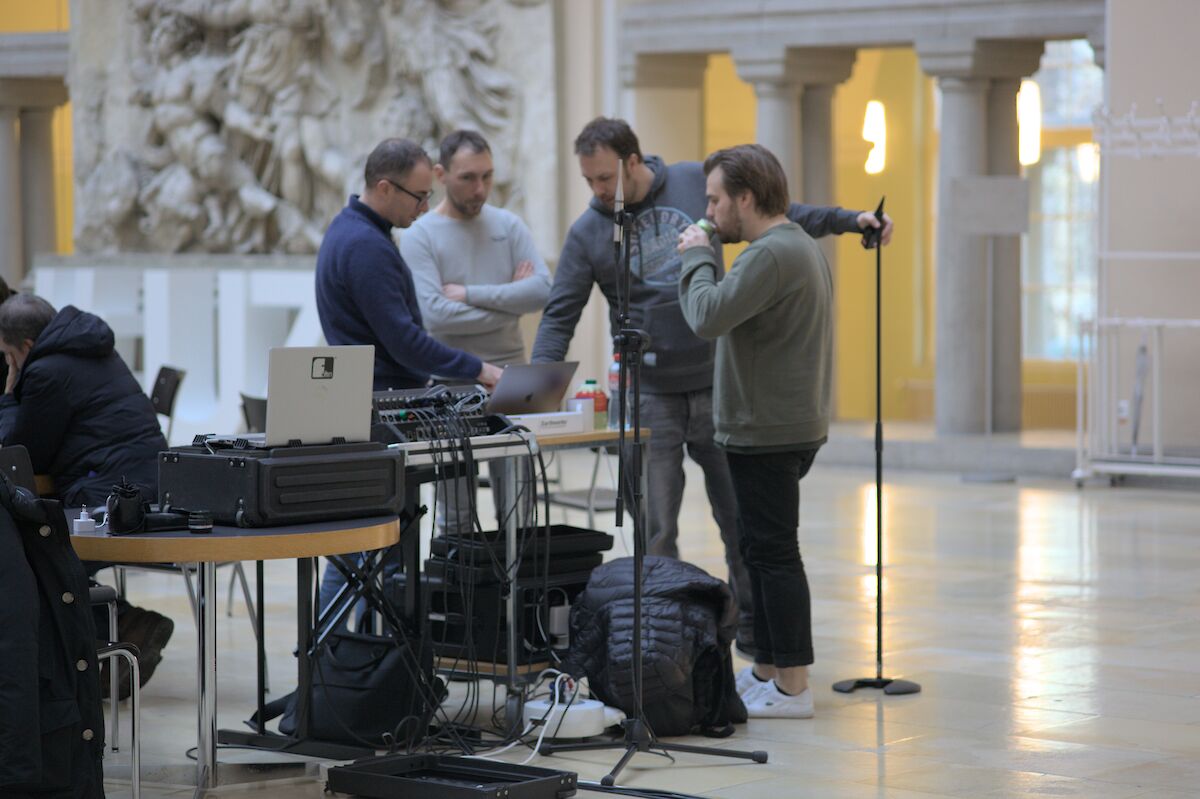




University of Zurich Lichthof (Atrium)
Last Friday afternoon, we went to Zurich University’s (UZH) historic atrium (“Lichthof”) to participate in a test, comparing different loudspeakers with and without Illusonic Clarity, for live speech and music reproduction.
The different loudspeaker systems under test were:
– A: Foohn FP-22 portable speaker
– B: Foohn LX-150 line-source speaker
– C: Foohn DLI-230 dsp-controlled line-source speaker (array almost twice as long as B)
From A, B, to C was clear improvement, in terms of intelligibility and reduction of reverberance.
For Clarity, we measured two microphone positions for each loudspeaker type. Based on the measurements, we specified bass, low, mid, and high acoustic parameters, including RT60. These parameters were loaded to Raspberry Pi (Raspi), on which Clarity ran with 3 ms latency. The Raspi was connected to the mixing console via analogue.
For C, Clarity clearly reduced reverberance of the Atrium, even on all-behind positions. Clarity’s effect adds to the line array’s beamforming improvement.
For A and B, Clarity also clearly reduced reverberance at positions not far beyond reverberation radius. Once the soundfield is fully diffuse, there is nothing to win. So A worked well and was improved by Clarity up to a certain distance (approx. 1/3 of length of Atrium). B extended that maximum distance, and C had reach up to end of Atrium.


19. December 2022
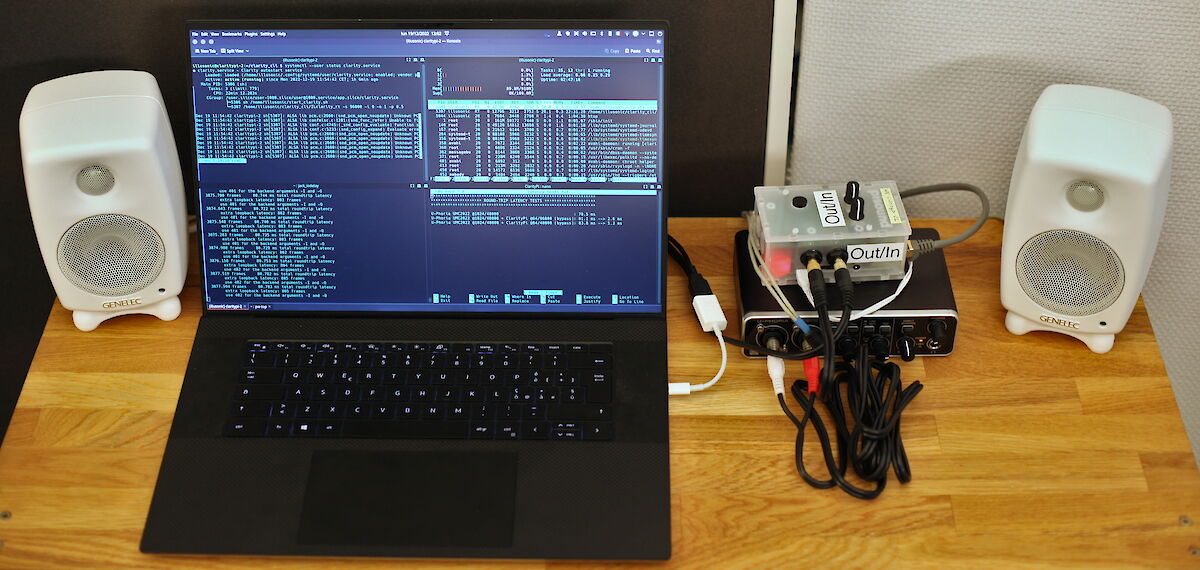

Real-Time Raspberry Pi Clarity Processor <3ms Latency
Clarity is our DSP-based room optimization technology, developed for nearly a decade. It optimizes a room beyond what room eq can do. It takes away parts of the source signal, which later on the room will add again. Perceptually, with Clarity, a music or PA system sounds as if the room would have more acoustic full range absorbers.
Clarity development was driven as a feature for our audio processors (IAP). A couple of years ago, we did exploratory tests in the Opernhaus Zurich, where Clarity is applied on the Studio stage (via our low delay plug-in).
Mid January a test is planned in the historic assembly hall of Zurich University. Acoustics are not satisfactory there, and acoustic treatment possibilities are very limited. We have had another request from world-renown ETH Zurich assembly hall. Though, as they were not looking for experimentation, but a device, we had to decline.
We can’t pull off another hardware device (besides IAP) and an entirely new business. But in order to small volume provide to selected venues Clarity, how can we build in low volume with low cost a hardware device?
Take a Raspberry PI 3 (Raspi), add a high quality stereo ADC and DAC and chassis. Bill of materials of USD 200 per unit! The rest of the problem is software:
1
Latency !
Usually a problem with Linux based systems. ADC and DAC connect via I2S, which is already better than USB. Then, we use Arch Linux ARM, which runs Clarity with maximum real-time priority round robin scheduler. The Arch Linux has only 14 processes running in total, so almost complete CPU is dedicated to audio processing. In order to reduce heating, the CPU is configured to run at minimum frequency (600 MHz instead of 1.4 GHz). Processing buffersize at 48 kHz is 32 samples. A daemon logs audio hick-ups. Several days of running it reported no hick-up at all. Externally measured latency is 2.7 milliseconds! This is low enough for any live application.
2
Reliablity !
The system is configured such that when starting the Raspi it will automatically start running Clarity. A daemon is monitoring it. In case audio processing crashes, it will automatically be restarted within a few seconds. Also, the Raspi may be disconnected any time from power. To mitigate risk of some data damage of its memory card, the file system is configured such that never data will be written to it. Any written data goes just to RAM.
3
Configuration and Tuning
To tune the system, a macOS/Windows/Linux software has been developed, writing a config file to the Raspi, containing all parameters. Real-time changes are possible. Parameters are permanently stored in Raspi. So it just has to power on to do its job. Besides Clarity, we also added parametric equalizers.
Let’s see, if the mentioned historic assembly halls will get substantial improvement thanks to Clarity. If yes, we have now a possibility to deliver a device that can do this job. Once this goes through well, other doors will be opened. This is iteratively working the ladder up, step by step, to possible success.


3. October 2022
Christof Faller

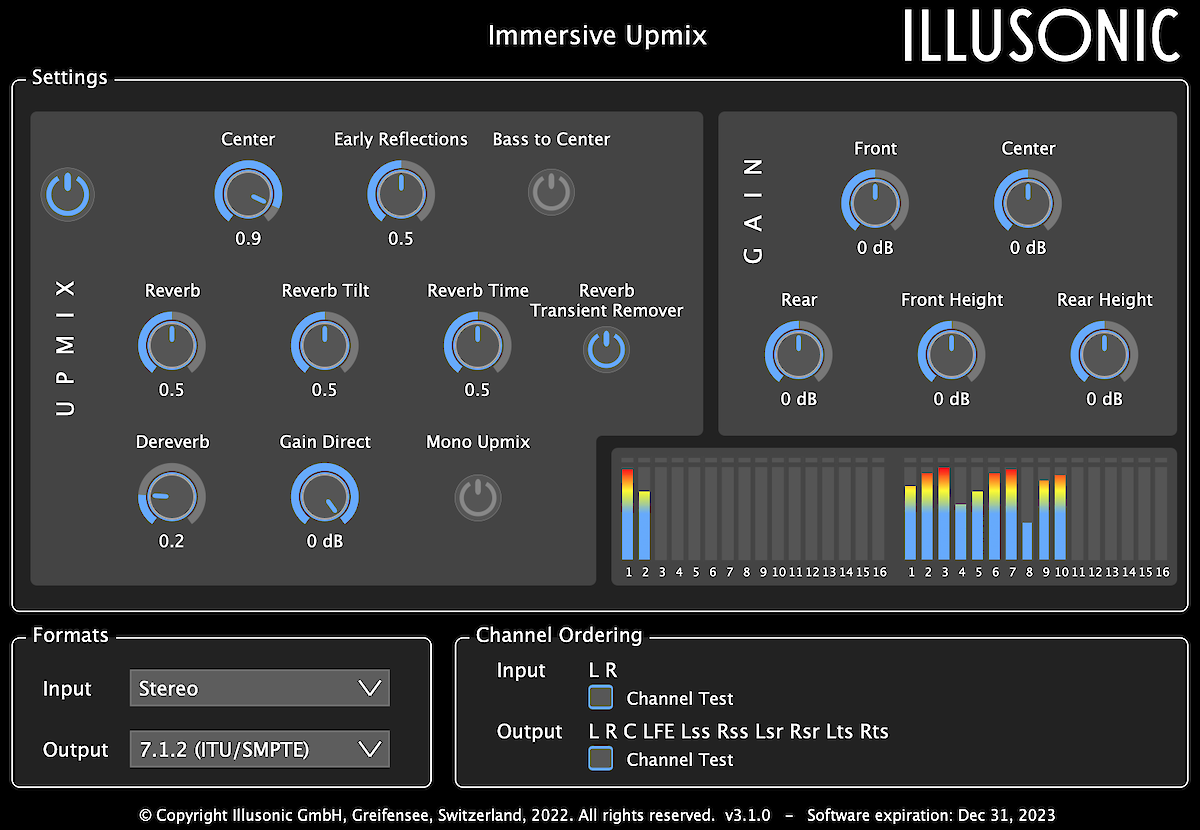

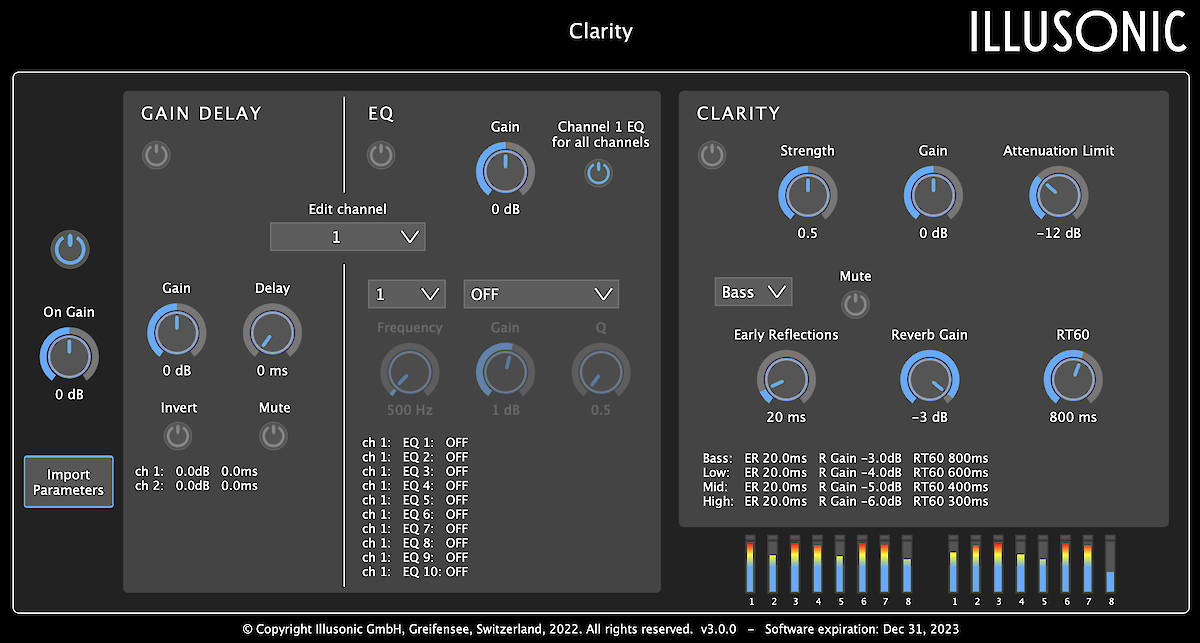
Major revision of immersive upmix and clarity
IAP Update 8.4
Pro Audio and Automotive projects have been the driver for update of our Immersive technologies. Dozens of Dolby Atmos music productions have used our upmix plugin for its great sounding reverb (depth, immersion) and phantom-center extractor (center). Alone since our previous IAP release, half a year ago, we did update our plug-ins three times, based on user’s needs.
With Version 8.4 we are consolidating these improvements for our IAP users. Depth and Immersion are fully revised and now allow for more effect. Clarity is more effective with less timbral change.
Changelog (8.3 => 8.4):
adapted apps for macOS 12 and Win 11
revised Clarity, less timbral change, improved performance without tuning
revised Depth, improved early reflections, preprocessor, and equalizer
replaced Immersion, new de-correlators
sound and timbre is now similar for all supported loudspeaker setups, previously front-only setups were quite different to surround setups
orientation left, right, rear improved (depth better adapted)
fixed bug, where default presets had mono upmix on instead of off


13. April 2022
Christof Faller

Depth and Immersion reach a new level of quality
IAP Update 8.3
Since the last update, we have had good progress on our immersive technology (Depth, Immersion features), being used in our upmix, binaural, plug-ins, and automotive licensable products.
We back ported these improvements to IAP SHARC DSP. Depth and Immersion have never been so nice as now. This also allowed us to make these effects a few dB stronger, while maintaining clean sound.
List of main changes:
revised dsp depth
revised dsp immersion
fixed bug, where immersion pre-delay was too large (echo effects)
fixed bug, where mono upmix could not be switched on
IAP Calibration delay trim slider now updates time plot in real-time
IAP Configuration layout improvements
Download the update here.


26. October 2021
Christof Faller

IAP 8.2 refines Immersive and Clarity algorithms
IAP Update 8.2
Feedback from our pro-audio plug-ins and a master diploma thesis on Clarity injected innovation into our IAP product line.
IAP 8.2 improves many “Illusonic” algorithms, such as depth, immersion, and clarity.
New ad hoc center gain feature allows to change gain of center, even without a center loudspeaker.
Input delay range has been increased to 300ms, satisfying even the most complex time alignment needs in home cinemas. Believe it nor not, a high end system with high end projector needed more than the previous maximum 200ms.
Besides that, IAP software has been internally modernized and runs now natively also on Macs with Apple Silicon.
Download the update here.


15. June 2021
Christof Faller




Farewell concert livestream and video with 3D audio
Farewell Concert Fabio Luisi
Opernaus Zurich, Saturaday June 19, 2021, 19:00
The livestream and video on demand will be available free of charge on the web link above from Saturday 19 June at 7pm until the end of June.
3D Sound
Viewers will be able to choose between stereo and 3D sound. The 3D sound is made for headphones listening. By directly controlling the listener’s ear input signals, an illusion of “being at the opera” is generated. Sound is recorded with an Ambisonics and other microphones and real-time processed with Illusonic’s microphone-to-3D-sound conversion audio processing software.
More details on the concert and its 3D sound can be found on opernhaus.ch


9. June 2021
Christof Faller
APEI Webinar - Remote Sound Tuning of Automobiles
APEI Webinar
Remote Sound Tuning in Automobiles (video available)
June 9, 2021
9:00 AM Pacific (12:00 PM Eastern)
Remote Tuning
Illusonic is maybe the company with most remote tuning experience. Almost a decade ago, we introduced the first Illusnoic Audio Processor. Shortly thereafter we introduced IAP Calibration software, with which Hi-Fi and home cinema customers measured their systems. With the same software we could remote-tune the custoomers’ systems.
Initially, remote tuning was done based on simulated frequency responses after tuning. Later, we added auralization and were so able to listen into customers’ listening room via headphones.
IAP Calibration software, specifically taylored for automotive is called CalibrationTool Automotive. It can handle up to 64 loudspekaer channels and 64 microphone positions.
Remote Tuning of Automobiles
We had already frequenty applied remote tuning to automobiles. It was mostly related to Immersive demos, for which we also linearly tuned the cars. Thanks to remote pre-tuning, we could minimize the time we had to spend with the actual car.
With the 2020/2021 Covid crisis and travel restrictions, remote tuning of automobiles quicly became a popular topic and we have seen a lot of traction in this direction.
Remote Tuning of Automobiles
During the webinar we show in real-time usage of CalibrationTool Automotive. It is shown by means of examples on how to remote tune based on data and graphs. The headphones auralization feature with head-tracking is also shown in real-time operation. During tuning, parameters are changed and simulated car sound in headphones changes immediately.


27. May 2021
Christof Faller


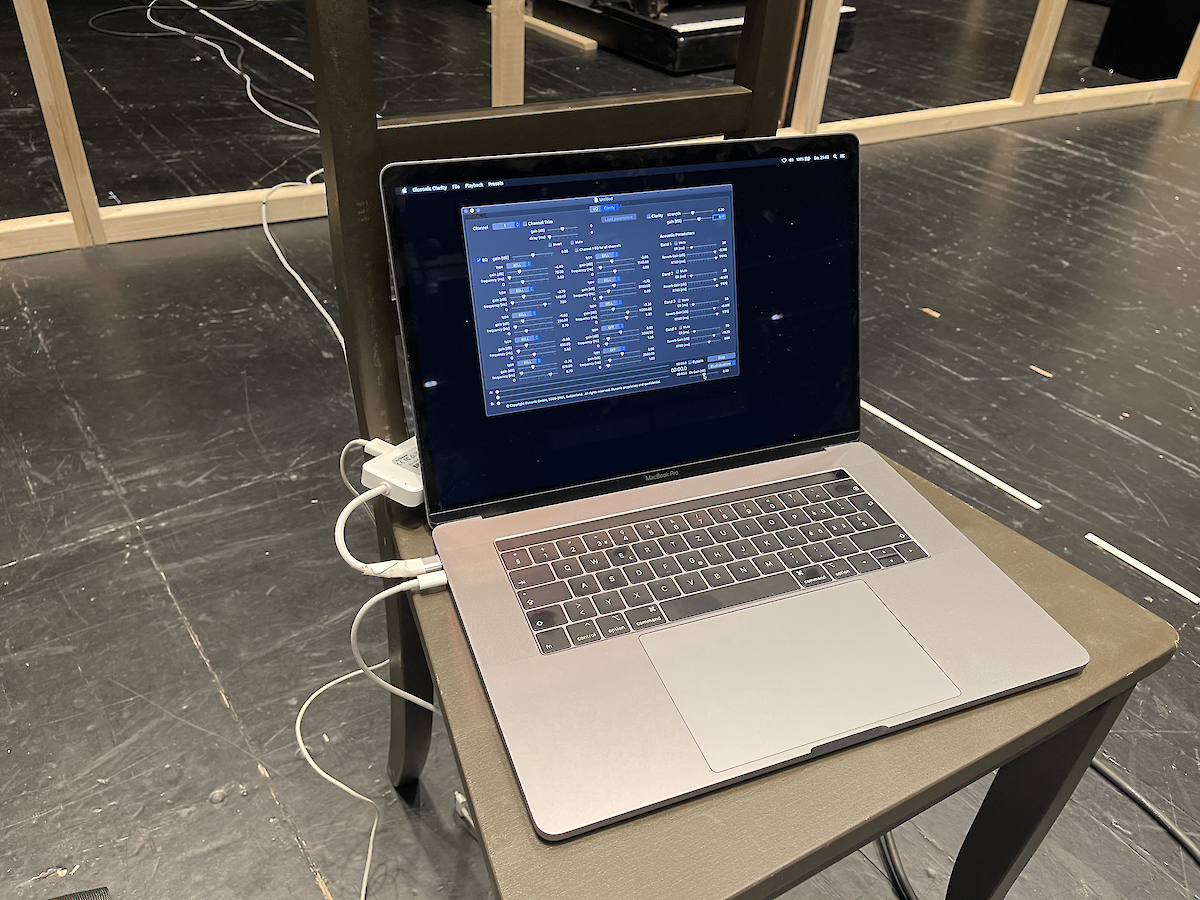
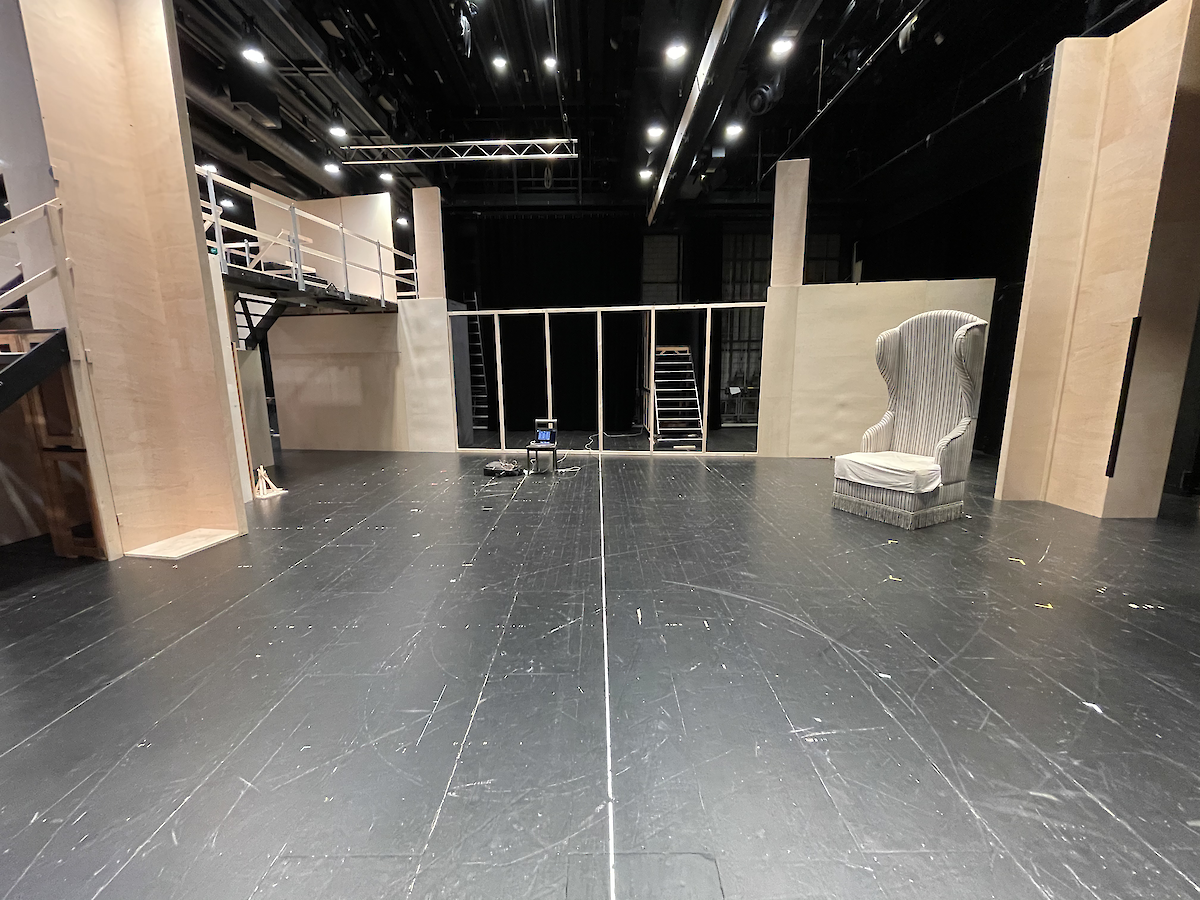

Clarity test on studio stage
The test at Opera Zurich for stage monitoring (previous blog-item) currently can not be finished as the orchestra can’t play on-site.
A second stage inside the opera, called “Studiobühne” (“studio stage”), used for practising or performances with smaller audience, is often used with amplified voice and reproduced sound.
This room is not a lot acoustically absorbed, say, a bit more reverberant than ideally desired.
Thus ideal for a first live test of Clarity in the opera.
Will Clarity benefit reproduced sound here?
Will Clarity benefit live amplified voice?
As it is quite complicated configuring a workstation with plug-ins for minimum delay, we developed in the meantime a low-delay standalone macOS application with less than 3m total delay. This app can be used with (high quality) sound cards (analog, ADAT, MADI) and even Dante.
Michael Utz measured the studio stage with Illusonic CalibrationTool software (aka IAP Calibration) and tuned it with EQ and Clarity. Once ready, he invited us for subjective testing on-site. The real-time test was carried out with the low-delay macOS Clarity application, connected to the mixing console via Dante.
Clearly reverb in room is reduced, sound is more clear and more focused from the loudspeaker positions.
We tested speech with wireless microphones. Feedback threshold was significantly increased (4-7 dB) and speech was perceived as more clear.
That’s great! Hopefully a live-test ona real public-performance will be admitted soon! :-)


16. March 2021



A major update to Immersive: IAP 8.1
More than a year ago, we released IAP’s Immersive Upmix algorithms as a “Test Balloon Plug-In” for music producers and sound engineers. This plug-in works with workstations such as ProTools, Reaper, Cubase, and Logic.
The plug-in has been widely applied worldwide for things such as Dolby Atmos music production, applause upmix, film music, etc. The Test Ballon Plug-Ins Program has brought us a wealth of pro audio feedback. This feedback has allowed us to evolve Immersive Upmix to a great degree.
Now we deliver latest Immersive Upmix, same as in latest plug-in, to our IAP customers via IAP 8.1 Firmware/Software update. Free of charge.
Additionally, the update incorporates many more improvements and bug fixes.
Download the update here.
Change Log (since 8.0..4):
IAP Firmware:
major update to Depth
major update to Immersion
got rid of dry center
new mono upmix option
improved LRC quality
improved Clarity time resolution
IAP Configuration:
added new mono upmix option, and removed dry center
added volume and mute control
kept macOS minimum requirement at 10.6
IAP Calibration:
improved Clarity optimization algorithm
extended Clarity visualization,
added new mono upmix option, and removed dry center
dozens of small improvements
set macOS minimum requirement to 10.11 (from 10.6)
bug fixes

